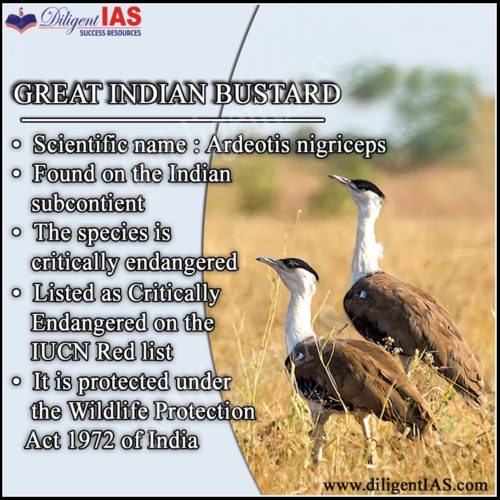Wildlife Institute of India report on Great Indian Bustard 30/07/2019 – Posted in: Blog – Tags: Wildlife Institute of India
GREAT INDIAN BUSTARD
For: Preliminary & Mains
Topics covered: Wildlife Institute of India report on Great Indian Bustard, Threat, Suggestions, Way forward
News Flash
The Great Indian Bustard is nearing extinction due to collision with high voltage power lines that criss-cross their flying path.
Key Findings
- The report is prepared by the Wildlife Institute of India, a statutory body.
- Wildlife Institute of India said only 150 GIBs are left, with the maximum number in Jaisalmer.
- They are dying at a rate of 15% annually due to collision with high voltage power lines.
- The GIB population has been reduced by 75% in the last 30 years.
- The mortality of adult GIBs is high due to collision with power lines.
- All bustards are prone to collision due to their poor frontal vision and inability to see the power lines from a distance.
- The study recorded that 15% of the GIB population may be dying because of this threat.
- The natural death rate of large bustards is 4-8%.
- The current additive mortality rate due to transmission lines is significantly higher and if not controlled, can result in the species extinction.
- Many other birds also die because of collision/electrocution with these transmission lines at the rate of 10 birds per km per month.
Need of the hour
- Lakhs of birds die every year due to power lines. There is an urgent need to put bird diverters and underground the power lines to bring the mortality rate down.
- Protection and conservation of GIB is the need of the hour.
Great Indian Bustard
- The Great Indian Bustard (GIB) is a critically endangered bird with less than 150 individuals left in India.
- The maximum number of GIBs were found in Jaisalmer and the Indian Army controlled field firing range near Pokhran, Rajasthan.
- Other areas where they are found are
- Kutch (Gujarat)
- Nagpur, Amravati, and Solapur (Maharashtra)
- Bellary and Koppal (Karnataka)
- Kurnool (Andhra Pradesh).
- The GIB is one of the heaviest flying birds endemic to the Indian subcontinent.
- They are primarily terrestrial birds.
- The GIB lays one egg every 1-2 years and the success rate of these eggs is 60-70 percent.
Threats to the GIB
- Irrigation and farming technology, mining, wind turbines, and associated infrastructure growth have caused severe habitat degradation to birds, including GIB.
- Recent developments in irrigation and farming technologies have intensified agriculture and changed cropping practices from seasonal to year-round intensive crops.
- Because of frequent ploughing and cropping or use of pesticides, there is a lack of food and vegetation cover to meet the ecological requirements of the species.
Proposed Suggestions
- There is a need to regulate intensive agricultural land-uses to achieve long term GIB persistence.
- Ill-informed forestry practices by state forest departments such as plantation of exotic shrub/tree species in deserts and grasslands in the name of afforestation have also degraded the habitat of GIB and other open habitat species that prefer visibility and openness.
- Mitigate power transmission lines passing through priority bustard habitats identified by the WII by undergrounding cables or installing bird diverters to make them prominent to birds.
Way Forward
- The government has released funds for the conservation of the GIB through a project.
- The project is titled as ‘Habitat Improvement and Conservation Breeding of Great Indian Bustard-An Integrated Approach’.
- The project is for five years from the Compensatory Afforestation Fund Management and Planning Authority (CAMPA) for conservation.
- The breeding of the GIB with technical support will be provided from the WII.
Source: The Hindu
Also, read more daily News
- GST rate cut on Electric Vehicle
- Rising Temperature caused by “Omega Block”
- Addressing the challenge of Red Mud
- UK-India Education and Research Initiative (UKIERI)
- International Tiger Day – 29 July 2019
You are on the Best Online IAS coaching platform. You are learning under experts.
We are present on Facebook- Diligent IAS, LinkedIn- Diligent IAS, YouTube- Diligent IAS, Instagram- Diligent IAS. Get in touch with us.

